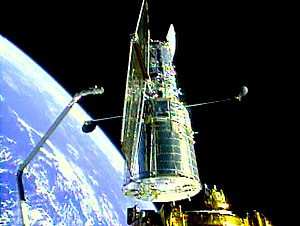Universe Reveals More Tantalizing Hints Of Possible ET
Life
 NASA's Hubble Space Telescope has
discovered carbon dioxide in the atmosphere of a planet orbiting
another star. This breakthrough is an important step toward finding
chemical biotracers of extraterrestrial life.
NASA's Hubble Space Telescope has
discovered carbon dioxide in the atmosphere of a planet orbiting
another star. This breakthrough is an important step toward finding
chemical biotracers of extraterrestrial life.
The Jupiter-sized planet, called HD 189733b, is too hot for
life. But the Hubble observations are a proof-of-concept
demonstration that the basic chemistry for life can be measured on
planets orbiting other stars. Organic compounds also can be a
by-product of life processes, and their detection on an Earthlike
planet someday may provide the first evidence of life beyond our
planet.
Previous observations of HD 189733b by Hubble and NASA's Spitzer
Space Telescope found water vapor. Earlier this year, Hubble found
methane in the planet's atmosphere.
"Hubble was conceived primarily for observations of the distant
universe, yet it is opening a new era of astrophysics and
comparative planetary science," said Eric Smith, Hubble Space
Telescope program scientist at NASA Headquarters in Washington.
"These atmospheric studies will begin to determine the compositions
and chemical processes operating on distant worlds orbiting other
stars. The future for this newly opened frontier of science is
extremely promising as we expect to discover many more molecules in
exoplanet atmospheres."
Mark Swain, a research scientist at NASA's Jet Propulsion
Laboratory in Pasadena, CA used Hubble's near-infrared camera and
multi-object spectrometer to study infrared light emitted from the
planet, which lies 63 light-years away. Gases in the planet's
atmosphere absorb certain wavelengths of light from the planet's
hot glowing interior. Swain identified carbon dioxide and carbon
monoxide. The molecules leave a unique spectral fingerprint on the
radiation from the planet that reaches Earth. This is the first
time a near-infrared emission spectrum has been obtained for an
exoplanet.
"The carbon dioxide is the main reason for the excitement
because, under the right circumstances, it could have a connection
to biological activity as it does on Earth," Swain said. "The very
fact we are able to detect it and estimate its abundance is
significant for the long-term effort of characterizing planets to
find out what they are made of and if they could be a possible host
for life."
 This type of observation is best done on planets with orbits
tilted edge-on to Earth. They routinely pass in front of and then
behind their parent stars, phenomena known as eclipses. The planet
HD 189733b passes behind its companion star once every 2.2 days.
The eclipses allow an opportunity to subtract the light of the star
alone, when the planet is blocked, from that of the star and planet
together prior to eclipse. That isolates the emission of the planet
and makes possible a chemical analysis of its atmosphere.
This type of observation is best done on planets with orbits
tilted edge-on to Earth. They routinely pass in front of and then
behind their parent stars, phenomena known as eclipses. The planet
HD 189733b passes behind its companion star once every 2.2 days.
The eclipses allow an opportunity to subtract the light of the star
alone, when the planet is blocked, from that of the star and planet
together prior to eclipse. That isolates the emission of the planet
and makes possible a chemical analysis of its atmosphere.
"In this way, we are using the eclipse of the planet behind the
star to probe the planet's day side, which contains the hottest
portions of its atmosphere," said team member Guatam Vasisht of
JPL. "We are starting to find the molecules and to figure out how
many there are to see the changes between the day side and the
night side."
This successful demonstration of looking at near-infrared light
emitted from a planet is very encouraging for astronomers planning
to use NASA's James Webb Space Telescope after it is launched in
2013. These biomarkers are best seen at near-infrared wavelengths.
Astronomers look forward to using the Webb telescope to look
spectroscopically for biomarkers on a terrestrial planet the size
of Earth or a "super-Earth" several times our planet's
mass.
"The Webb telescope should be able to make much more sensitive
measurements of these primary and secondary eclipse events," Swain
said.
 ANN's Daily Aero-Term (05.01.24): Say Altitude
ANN's Daily Aero-Term (05.01.24): Say Altitude ANN's Daily Aero-Linx (05.01.24)
ANN's Daily Aero-Linx (05.01.24) Classic Aero-TV: Korean War Hero Twice Reborn
Classic Aero-TV: Korean War Hero Twice Reborn Airborne 04.29.24: EAA B-25 Rides, Textron 2024, G700 Deliveries
Airborne 04.29.24: EAA B-25 Rides, Textron 2024, G700 Deliveries Airborne Affordable Flyers 05.02.24: Bobby Bailey, SPRG Report Cards, Skydive!
Airborne Affordable Flyers 05.02.24: Bobby Bailey, SPRG Report Cards, Skydive!




